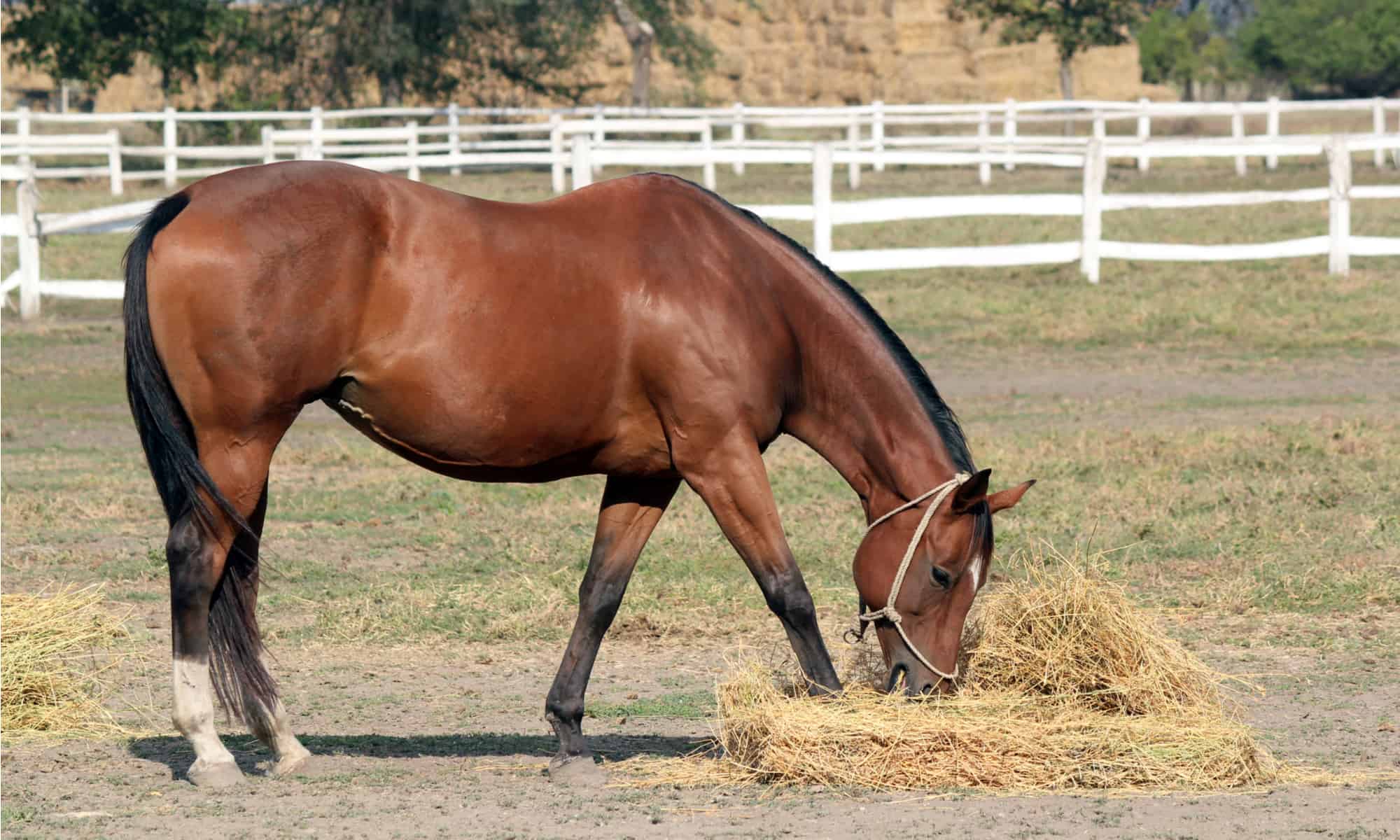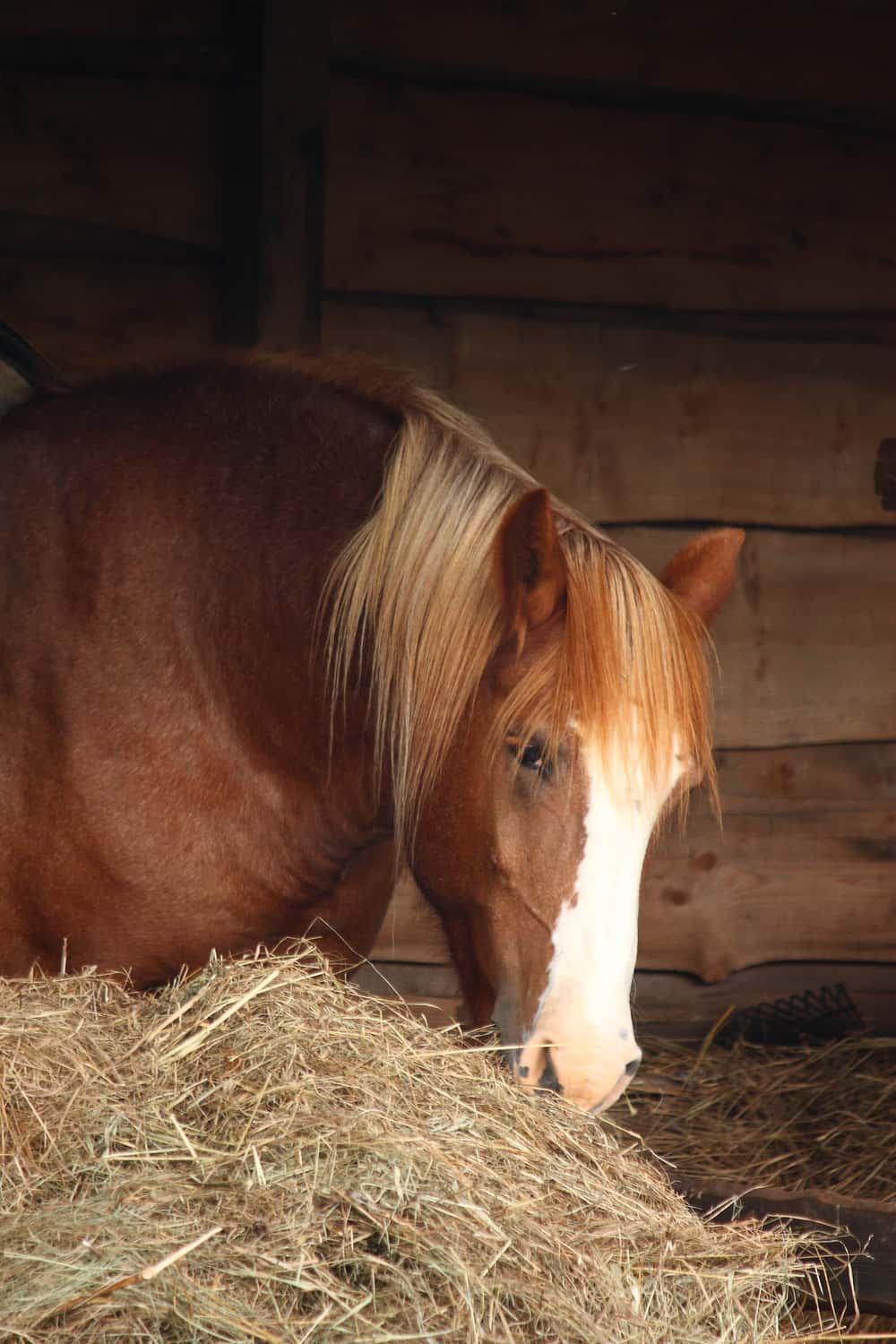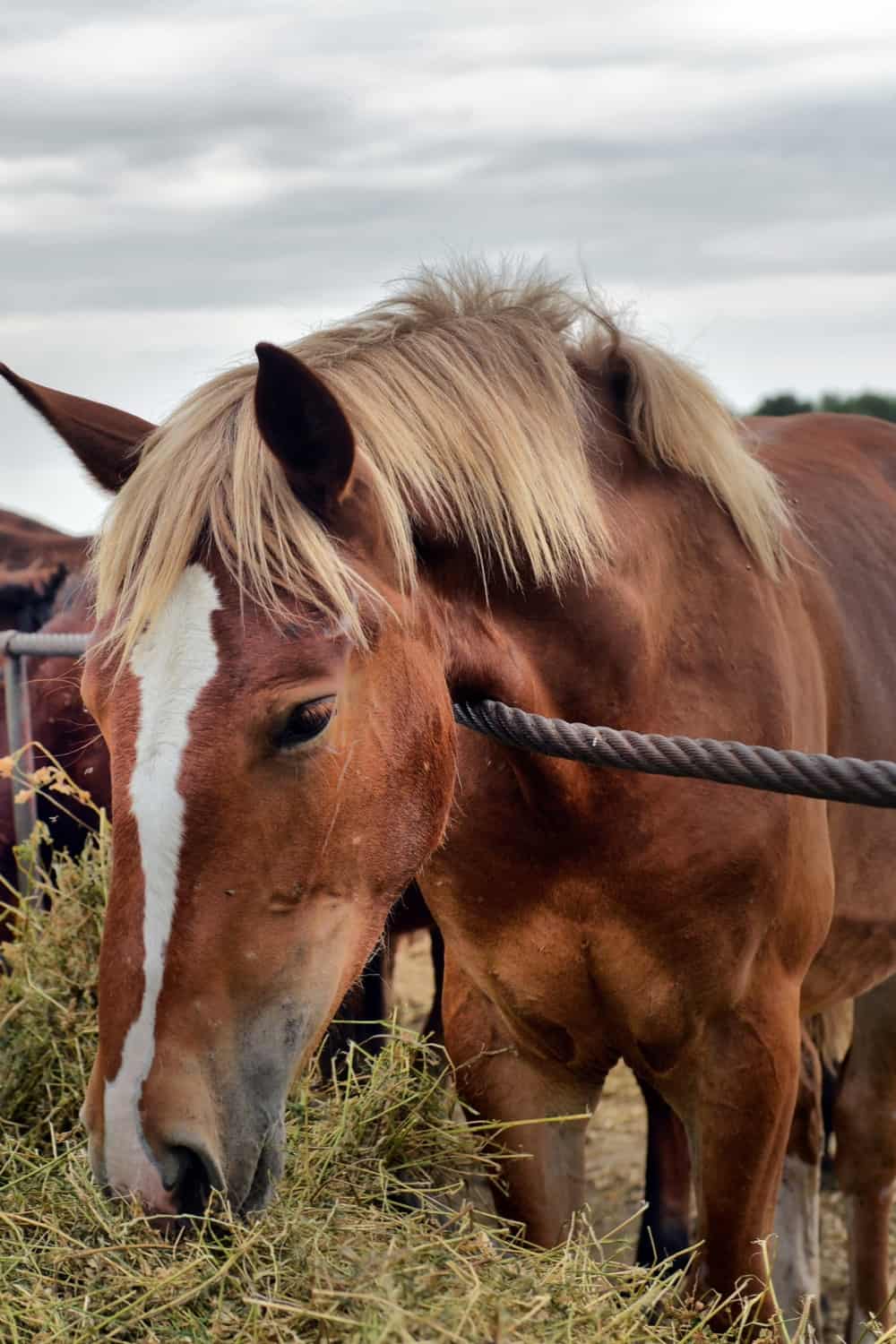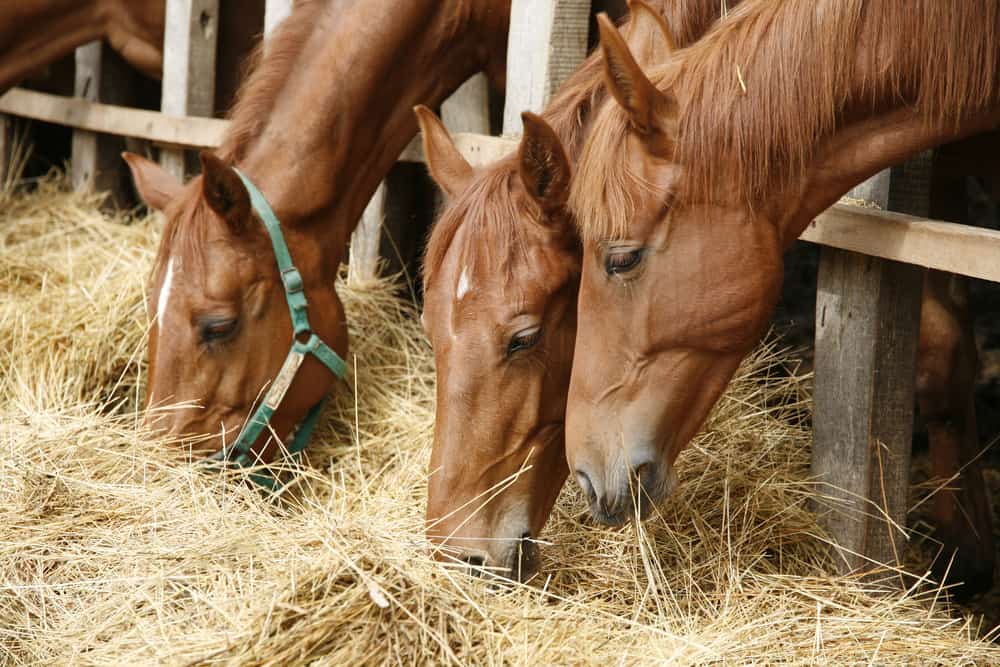Taking care of a horse is a lot of work. It will require a spacious ground, appropriate handling, training, regular exercises, and cleaning. However, the most demanding part of horse care is determining a proper diet.
Feeding your horses too much or too little will jeopardize their health. That is why you should calculate the right amount of food, especially hay, each horse needs. How much hay does a horse eat every day will depend on its size and the amount of work it does.
Proper Feeding
Overfeeding a horse will result in an obese animal. Believe it or not, many horses don’t have self-control and won’t stop eating when they are full.
On the other hand, not giving the horse enough food will cause unhealthy weight loss and lack of energy. In that case, the animal can also become prone to illnesses, particularly colic.
As you can see, knowing how much hay to give to your horse is crucial for its proper maintenance. There is a quick way to determine the base amount of food each particular animal needs. Therefore, it is vital to adjust the diet according to the specific needs of each individual.
Calculating the Right Amount of Hay
The first thing to know is that an average fully-grown horse weighing from 1,000 to 1,100 pounds (453.5 – 499 kg) should eat approximately 15 to 30 pounds (8 – 3.5 kg) of hay daily. That amount is about 1.5 to 3% of the horse’s body weight.
Therefore, it is necessary to measure your horse before determining its daily portions. That way, you can set the diet more accurately. You can calculate your horse’s weight in two ways:
Tape
Use tape to measure the horse’s body length and girth. You can quickly calculate its approximate weight using simple formulas:
girth x girth x body length / 300 = adult horse weight in pounds
girth x girth x body length / 299 = pony weight in pounds
girth x girth x body length / 301 = yearling weight in pounds
girth x girth x body length / 280 = weanling weight in pounds
Scale
Use a livestock scale to measure your horse more accurately. Unfortunately, it is not always practical to find. Places like veterinarian clinics or auction bars often have livestock scales, so you can try measuring your horse there.
Horses Requiring Special Attention
The next thing to consider is how much work your horse does. If you use it for pleasure rides a few hours a day, the average amount of food should suffice. However, the horse that regularly works as a draft animal spends much more energy, so it needs more food.
The horse’s diet also requires adjustments if the horse is still growing or if the female horse is pregnant or nursing a foal.
Different Horse Breeds Feeding
Keep in mind that different horse breeds have diverse feeding needs. In other words, draft breeds will need more hay than an average size horse. For instance, horses like English Shire, a Belgian horse, or French Percheron are much larger than regular ones and need more food.
People use these draft breeds for heavy draft and farm work. Since they often work more hours a day, they need more food to give them enough energy.
On the other hand, ponies that are considerably smaller than regular horses and have a slower metabolism will consume less hay. Plus, ponies rarely work hard, as people mostly keep them as children’s riding companions nowadays.
Most ponies need to eat only 1 to 1.5% of their body weight. For example, a Shetland pony that weighs from 440 to 880 pounds (200 – 300 kg) needs about 4.4 to 13 pounds (1.9 – 5.9 kg) of hay per day.
Combined Diet
As you know, hay is dried grass. The horse’s hay intake will change depending on how much other food it eats. That includes fresh grass, roughage, fibrous bulks, and grains like oats, barley, corn, wheat, and soybeans.
Horses should spend most of the day on a pasture since grazing is their natural feeding routine. For instance, wild horses spend up to 16 hours a day grazing.
If your horse is often outside, grazing freely, you should reduce the amount of hay you give them. Doing this is crucial, especially in the early summer when the grass has the highest nutritional content so that a horse can take too many calories.
On the other hand, your horse will need more hay if you keep it in a stall most of the time.
Combining Grains and Hay
Eating forage (grass or hay) should be enough for the horse to get all the required nutrients. If you choose to implement grains into your horse’s diet, it is necessary to reduce the hay amount.
It is not complicated to calculate the correct amount of each food using the same principle as when feeding your horse only with hay.
Let’s say you have a horse of 1,000 pounds (453.5 kg). That horse will need approximately 2.5% of its weight in food or 25 pounds (11.5 kg) of grass, grain, and hay combined.
If you offer your animal 5 pounds (2.3 kg) of grains a day, base math shows that it will need 20 pounds (9 kg) of hay daily.
5 pounds (2.3 kg) grain + 20 pounds (9 kg) hay = 25 pounds (11.5 kg)
Feeding a Horse with Hay in Winter
As I have already mentioned, the primary source of food for horses is pasture. However, they can’s graze during winter, like during spring and summer, because the pasture grass is limited in that period of the year. It is dry and has lesser nutritional value.
Therefore, you should adjust your horse’s food rations when winter comes. During this time, horses get most calories and nutrients from hay. In other words, you should provide more hay for it in winter than in summer.
Another reason why the appropriate hay supply is crucial for horses when it is cold is that it keeps them warm. Digesting hay produces energy, and that process raises the horse’s body temperature. So, the colder it gets outside, the more hay your horse needs to eat to get the desired warming effect.
How many times a day you feed your horses is also crucial in keeping them warm. A natural way of feeding includes consuming small but frequent portions of hay throughout the day.
That helps digestion and allows the horse to use more nutrients out of every bite. Since digestion provides energy and keeps the horse warm, it is recommended to offer it a larger evening portion to keep it warm the whole night.
Feeding Routine
The rule of thumb is to feed your horse with multiple but smaller portions of food throughout the year, not only when it is cold. This way, you can imitate a horse’s natural way of feeding on a pasture.
Horses have a specific digestion system, with a long colon, made particularly for digesting plant fibers. You should be aware that a horse can get colic if its colon is not regularly full.
In other words, your horse can suffer from abdominal pain if it doesn’t eat enough. The same thing is with digesting all food at once, leaving the digestive system without work for the rest of the day.
The best way of keeping your horses healthy is by establishing a strict feeding routine. One more thing! Remember that horses have an exact internal clock, so you need to feed your animal at the same time every day.
Hay Bales and Flakes
When feeding a horse, it is helpful to divide hay into smaller portions so you can track more accurately how much it eats. To do that, you can separate the hay bales into flakes, the bale sections you can divide by hand.
The number of flakes in a bale is not always the same, but you can probably get a dozen of them from each square bale. Knowing an average bale of hay weighs about 60 pounds (23 kg), you can quickly calculate the weight of each flake.
The math is not complicated at all. It is necessary to count the number of flakes in a bale and then divide the bale’s weight by the number of flakes. Since you know that a bale of 60 pounds (27 kg) has 12 flakes, each weighs 5 pounds (2.3 kg).
As I have already mentioned, a horse of 1,000 pounds (453.5 kg) needs to eat 25 pounds (11.5 kg) of hay a day. Therefore, you need to offer it five flakes of hay daily, preferably in five meals. Keep in mind that not all flakes weigh the same, so check them carefully.
Summary
Providing your horses with the right amount of hay is crucial for their health. An average horse of 1,000 pounds (453.5 kg) needs approximately 15 to 30 pounds (6.8 – 13.5 kg) of hay a day. However, you should consider your horse’s size and the amount of work it does when determining its diet.












I WANT TO BE SURE I GET THIS CORRECT THIS WULL BE THE FIRST TIME I HAVE HAD TO FEED HORSES FOR THE WINTER CAN U GIVE AN APPROX AMOUNT OF HAY I NEED TO ORDER FOR 3 HORSES 1100 WEIGHT 2 ARE LIGHTLY RIDDEN ONE A BARREL HORSE SO LOW ACTIVITY IN THE WINTER MONTHS..ONTARIO WINTERZ?
We are in Northern Idaho in the winter I am feeding at least approximately 40 pounds a day. We do about 20 to 25 pounds in the am and 25 to 30 in the pm for most of my 1100 pound horses. Since we don’t have year round cuttings by the time the cold sets in… the hay has lost some nutrients and they need more for that, and to produce warmth because we do not blanket and do not have shelter.
“-should eat approximately 15 to 30 pounds (8 – 3.5 kg) of hay daily.”
Quick correction, 30 pounds is about 14 kg so some typing here went a bit wrong :O